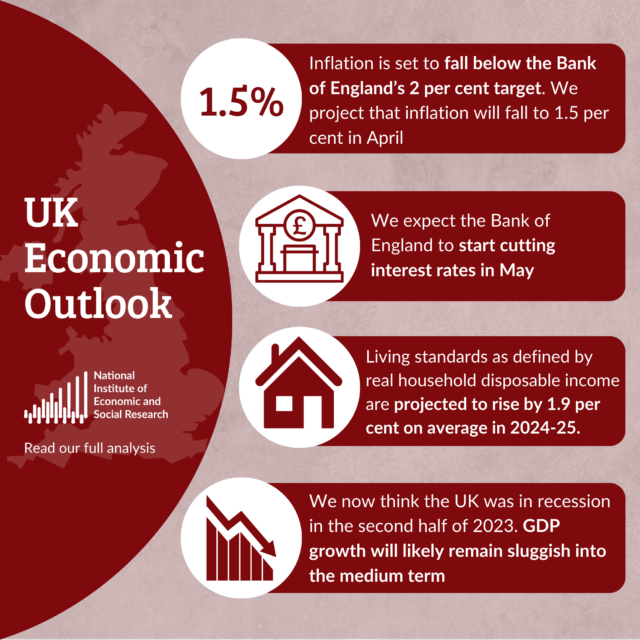The Geography of Skills and Productivity
Labelled “the productivity puzzle”, the UK’s decline in productivity since the 2008-2009 Global Financial Crisis has been called the “defining economic question of our age”, with its cause taxing both policy-makers and economists alike. Explanations have ranged from structural issues around new regulations, through to lack of investment and changing trade patterns. In this post, Dr Issam Samiri, in conversation with Professor Stephen Millard, explores the impact that the regional variations of skills, income and wealth can have on overall productivity.

What do we mean by productivity and how is it related to the ‘skills’ of the workforce?
Productivity is a measure of economic performance that compares the goods and services produced to the inputs used during the production process. Economists usually focus on two production inputs: labour and capital. Productivity can, therefore, measure how efficiently we are using each of these inputs. This would be labour productivity in the case of labour input or capital productivity in the case of capital input. Historical data shows that labour productivity is closely related to living standards, hence the focus on labour productivity in policy and public debate. Labour productivity is typically measured as output per hour worked. This is a measure of the volume of goods and services produced by the average worker in an hour.
A standard way to study the behaviour of labour productivity at the national level is to decompose its performance into three important components. The first component is related to the intensity of capital use in the production process, measured as the level of capital per hour worked. The second component is labour composition, a proxy for the workforce’s skill level. The third component is a residual that is often interpreted as a loose proxy for the state of technology within a particular country. We usually call this residual Total Factor Productivity or TFP.
The workforce’s skill is one of the three main factors driving productivity performance. Since the Global Financial Crisis (GFC), the UK has been plagued by weak labour productivity growth. This disappointing performance was mainly due to an underwhelming growth of capital and TFP. However, ONS measures of the skill of the average UK worker show a marked improvement since 2008. This improvement in the quality of the workforce has been one of the few silver linings of the UK productivity story since the GFC.
How does productivity and skills vary across the UK regions?
London’s labour productivity is about 30% higher than the UK average and about 50% higher than productivity in Yorkshire and the East Midlands. This is a substantial difference by international standards. The UK has one of the most uneven regional distributions of productivity of the OECD countries. This is a structural feature of the UK economy; these levels of inequality are comparable to those measured twenty-five years ago. While the uneven distribution of UK productivity is not a recent phenomenon, it is worthy of the attention it has been receiving recently. The uneven geographic distribution of productivity implies an unequal distribution of income and wealth across the country’s regions. These inequalities are more visible and have more social and political repercussions in the current context of low economic growth.
Given the important role played by the workforce’s skills in determining productivity outcomes, it is no surprise that skills are also very unevenly distributed throughout the UK regions. For instance, about 6 in 10 London workers have an NVQ4 or better qualification. This ratio drops to less than one in four in Hull. Human capital is a measure of knowledge, skills, competencies and attributes embodied in individuals. 2018 ONS estimates show that a worker living in the London region would possess, on average, about 80% more human capital than one living in the North East.
Where does commuting time and transport infrastructure fit into this story?
Commuting comes with a cost to workers. Of course, there is the obvious monetary cost. Then there is the time cost. The time spent commuting by a worker is not spent at the workplace and is, therefore, time that could be better used for work or leisure. An unnecessary long commute can be a waste of the physical and human resources dedicated to transporting workers and a loss of precious working time. Furthermore, an expensive and time-consuming commute could deter workers from taking higher productivity jobs located in certain areas.
The commute experience changes widely from one UK region to another. Before the pandemic, the daily commute took the average London worker 64 minutes a day. The commute time drops to 34 minutes for an average worker living in Leicester; it is even shorter for workers living in many of the UK’s rural areas. When a typical worker decides whether to move to London for a higher paid, more productive job, the longer commute times and the associated monetary costs would be one of the questions on their mind. The commute experience plays an important role in deciding the distribution of workers throughout the country, thus affecting the geographical distribution of productivity and skills.
What might we learn from a model about all of this?
The geographic distribution of productivity within a country is, in great part, determined by the geographic distribution of skills, and both these distributions are impacted by the nature of transport infrastructure and the resulting commuting habits. To consider all these issues together and account for the various competing effects is not a simple endeavour.
Considering some of the choices that a UK worker might ponder would help us understand the complexity of the various effects at play and their interactions. A typical worker needs to make several choices that affect their living location, work location, supply of labour, productivity, leisure time, consumption, commute time and costs, real estate spending and ultimately help determine their welfare. For example, the worker might want to consider where to live in the UK. If they decide to live in London, they will probably face steeper commute and real estate costs, but they are more likely to be paid a higher salary due to the positive agglomeration effects on wages. Conversely, if they live somewhere in the Northeast of England, they will be able to avoid London’s high living costs, but they are likely to be paid less than the wages prevailing in London for their industry or trade. Given that higher productivity London workers are likely to capture higher salaries than lower productivity workers while the living costs facing both types of workers remain the same, London would be more attractive to productive workers. A well-specified model would capture this effect, making London a destination for skilled UK workers. Now, a potential question is what would happen if people needed to commute much less due to a permanent change in working habits triggered by the pandemic related restrictions. Intuitively, this would decrease commute costs in the congested London area, pushing more workers to take London-based jobs. However, what would be the effects outside London? Would other areas of the country benefit from such a reduction in commuting times? What would be the resulting national distribution of productivity and skills? A well-specified, well-calibrated model could help answer these questions and more.






















